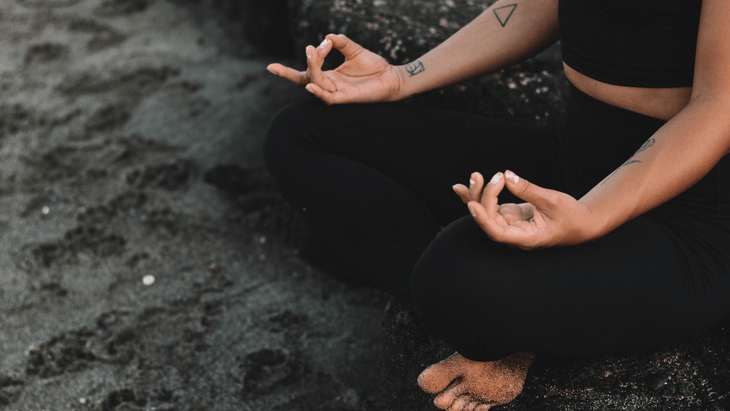12 Ways to Make Sitting in Meditation Easier
Yoga Journal
There’s a common misconception that meditation involves achieving some state of enlightenment or ease. If you’re distracted by a single thought, you’re not doing meditation correctly.
That simply isn’t true.
Meditation isn't about achieving a state of nothingness. Meditation is a path to becoming aware. It's becoming curious. It may shift your mood in the moment but also how you show up to your life. Ultimately, practicing meditation is choosing to show up regularly to something that helps you take responsibility for your sense of self.
There’s no denying that it can be challenging to sit still with yourself in meditation, especially if you’re new to it. Although it may not always be easy to practice, there are some simple techniques that can make it easier. The following suggestions have helped me and my students find an approach to meditation that is comfortable for the body and quiets the disruptive thoughts that inevitably arise.
12 ways to make meditation easier
1. Set the mood
You don’t need any fancy setup--or even a perfectly quiet environment--to sit in meditation. However, it may help to set the mood, whatever that means to you. Maybe you light some candles, string up some twinkly lights, or turn on some soothing music. Burn incense (though avoid burning sage or palo santo) or do some kind of cleansing ritual. You may choose to sit someplace outdoors that you find particularly soothing. Do whatever you need to derive the most out of your experience.
2. Prepare your body
Practicing a little slow yoga or stretching before going into meditation can help release physical tension. Remember that the physical practice of yoga was actually created specifically to prepare your body to sit still in meditation. Asana practice allows stuck energy to flow freely in your body and helps your mind settle more easily and deeply into quiet.
3. Set an intention
Take a moment to check in with yourself before you begin your meditation practice. Notice what comes up as a want or need at that time. While many meditation teachers say the practice shouldn’t be goal oriented, you may set an intention simply to commit to this meditation session. As you meditate, come back to your intention as needed to shift your focus away from stray thoughts and back to your practice.
4. Find a comfortable seat
For many of us, it’s difficult to sit in the traditional Padmasana (Lotus Pose) for an extended period of time. My legs tend to cramp or fall asleep and, because I’m uncomfortable, I tend to get fidgety and frustrated. I’m unable to show up fully to the experience. Being uncomfortable isn’t helpful or conducive to our experience of meditation.
If you prefer to sit cross-legged on a meditation cushion, you may want to elevate your hips so your legs don’t cramp or fall asleep. You can also sit on a yoga block with a blanket draped over it for extra comfort, or even sit in a chair with your feet planted evenly on the ground. Coming into Savasana (Corpse Pose) allows you to relax your entire body, so your breath will move more freely and your mind can be at ease. There are many different meditation postures. Experiment with what feels best in your body.
5. Start in smaller time increments
When it comes to how long to sit in meditation, think quality over quantity. It is absolutely not necessary to force yourself to sit in meditation for 30 minutes or longer--especially when you're new to it.
I find that 15 minutes is the perfect amount of time for me and many of my students to detachment from our thoughts so we can sink into stillness. But a shorter sit--even three or seven minutes--is still profoundly beneficial. You can always sit for longer when time permits. It’s the regularity of your meditation practice that matters the most.

6. Include a mantra
Chanting a mantra during meditation can be powerful because it gives your mind a job. The word “mantra” in Sanskrit means “mind tool.” Mantras are words that you can literally use as tools to help clear away the clutter in your mind so you can focus. Research supports the use of mantras as a means to minimize being distracted and calm the nervous system.
When you chant a mantra in Sanskrit, the sounds of the words are believed to have a particular vibration. There are literally thousands of mantras and it can be overwhelming to choose just one. I recommend starting with something simple, such as a one-syllable bija, or seed, mantra. For beginner’s I often suggest sat nam. “Sat” translates to "truth” and “nam” means "name." Together they translate into “truth is my name” or “truth is my essence.” Inhale on sat, exhale on nam. Any time you find your mind wandering, come back to it.
7. Incorporate malas
Malas, beads for prayer or meditation, allow you to take a more active approach to your practice by engaging you in the physical act of feeling each bead as you repeat your mantra. This can help you remain focused on the practice instead of getting lost in your thoughts.
To meditate with malas, start with your beads in your right hand. Hold the first bead from the right of the large guru bead, or charm, between your thumb and index finger. Recite your mantra and move to the next bead. Continue until you get to the last bead by the charm on the other side. After reciting the mantra with the final bead, take a moment to pause and focus on your breath before you complete your meditation.
8. Ground with crystals
When I notice my mind wandering, I can bring my focus back by focusing on how it feels to hold a crystal. I find that crystals help ground me and propel me deeper into myself. There are many kinds of stones-- each powerful in its own vibration. Some of my favorites include rose quartz, the stone of unconditional love, which inspires self-acceptance; selenite, a powerful cleansing stone, which helps clear the mind and dispel unwanted energy; and richly hued amethyst, which is believed to help induce calm, clear the mind, and bring peace.

9. Practice mudras
Many students rely on mudras to help with focus and create a deeper experience. A mudra is a symbolic physical gesture used as an energetic seal. Each part of your hand corresponds to a certain part of your body and mind. By curling, crossing, stretching, and touching your hands in specific ways, you influence your mind-body connection.
10. Try different meditation styles
There are many different approaches to meditation. My favorites include Transcendental Meditation, kundalini meditation, and loving kindness meditation. You can practice guided meditation or meditate silently alone; meditate while walking or listening to music. Learn and practice a few approaches to see what styles resonate with you and what brings you the experience that you want or need. This is your personal practice. It’s OK to experiment until you find an approach that maintains your desire to meditate again.
11. Let loose with your meditation
There is no right way to meditate. So have fun with it! You can shape and create your experience into anything you want. Meditation should not necessarily feel serious or like a chore.
12. Leave your expectations behind
Each time you meditate will be a different experience--and it may never be exactly what you expect. It helps to remember that meditation is not a place of self-judgment. Just show up to your practice. This is your time to sit and simply be in the present moment. Stay open to the experience and you will always get what you need.
About our contributor
Lua Briceno is a writer, artist, and trauma-sensitive certified yoga and meditation teacher specializing in hatha and Yin yoga. She is passionate about helping students develop a functional yoga practice that is nourishing for all bodies and backgrounds. You can find her at www.modernmoonchild.com.
For exclusive access to all of our fitness, gear, adventure, and travel stories, plus discounts on trips, events, and gear, sign up for Outside+ today.]]>

